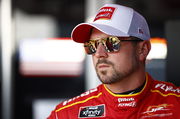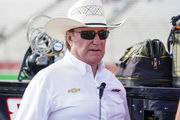
Imago
From motorsport.com

Imago
From motorsport.com
In the late 1980s, NASCAR’s “tire wars” between Goodyear and Hoosier brought blistering speed to the Cup Series. Softer compounds gave drivers more grip, but they also triggered safety concerns and high-profile blowouts, forcing NASCAR to step in. Ever since, tires have remained central to debates about race quality. Meanwhile, NASCAR poured millions into car research and development on diffusers, aerodynamic tweaks, and underbody changes. Yet after this weekend’s Richmond race, Kevin Harvick surprisingly pointed out that all the complexity faded into the background when Goodyear finally got its tire right.
Watch What’s Trending Now!
Tire problems are nothing new for NASCAR. The 2008 Brickyard 400 became infamous after widespread blowouts forced competition cautions every dozen laps. This prompted questions about whether Goodyear and NASCAR could ever guarantee both safety and strategy. That history made Richmond’s clean race stand out. Cars handled better, strategies developed naturally, and tire fall-off created passing opportunities. Still, not everyone agreed. Richard Petty warned, “When they threw the green flag, everybody said, ‘OK, what are we going to do on tires?’ Not, ‘What are we going to do racing each other?’” Yet, Harvick believes Richmond’s precedent may point toward a solution the sport has been chasing for decades.
ADVERTISEMENT
Kevin Harvick’s faith in Goodyear tires
For Harvick, the Richmond weekend proved a simple truth. “When you look at the race and talk about the tire Goodyear brought, all the strategy, the falloff, and everything that went into it, it was just a traditional NASCAR race,” he explained. The spectacle wasn’t a result of aerodynamic trickery but of a tire that rewarded drivers who managed grip and strategy. He underlined the point even further. “If the tire’s not right, it doesn’t matter how good the car is.” That statement cuts to the heart of NASCAR’s spending habits.
Over the years, the sanctioning body has invested millions in Next Gen R&D. But the results have been inconsistent, with short tracks often criticized for follow-the-leader racing. Harvick argued Richmond showed that the solution might not lie under the car at all. “NASCAR has spent millions of dollars on aerodynamics for this car, changing diffusers and making various modifications underneath the car,” he said. Harvick did not dismiss the work already done, but he called for urgency.
On his Happy Hour Podcast, Harvick also suggested a return to multiple tire codes tailored to track types, echoing NASCAR’s 1980s and 1990s approach when compounds were finely tuned to each venue. “I think everyone should check out Cole Pearn’s tweets and everything he’s talked about regarding the car.” His point was clear. Aero tweaks move the needle slowly, but the right tire compound can change a race overnight.
ADVERTISEMENT

Imago
NASCAR, Motorsport, USA NASCAR Cup Series Race at Richmond Aug 16, 2025 Richmond, Virginia, USA NASCAR Cup Series driver Austin Dillon 3 celebrates in victory lane after winning the Cook Out 400 at Richmond Raceway. Richmond Richmond Raceway Virginia USA, EDITORIAL USE ONLY PUBLICATIONxINxGERxSUIxAUTxONLY Copyright: xAmberxSearlsx 20250816_ads_si2_013
That approach could arrive just in time. With the playoffs looming, NASCAR faces mounting pressure to ensure competitive racing at its biggest stages. Richmond showed how much strategy and unpredictability tires can add. Whether Goodyear takes the risk and expands its compound offerings remains to be seen. But for now, Harvick’s words sharpen the debate. Spend millions under the car, or get the tires right on top of it.
ADVERTISEMENT
Top Stories
‘RIP’: NASCAR World Crumbles in Tears as 39-YO Former JR Motorsports Driver Passes Away

Courtroom Falls into Dead Silence as Heather Gibbs’ Heart-Ripping Account of Husband Coy’s Death Stuns the Trial

31-YO NASCAR Cup Team Joins Hands With Richard Childress to Leave Ford Alliance After 2025 Reality Check

What Happened to Bill Elliott? Does Chase Elliott’s Father Have Cancer?

Michael Jordan Exposes NASCAR’s Harsh Reality as Jim France & Family Faces Uncomfortable Questions

Harvick’s stern warning on Alex Bowman’s NASCAR playoff fate
For weeks, the NASCAR playoff bubble has focused on whether consistent performers like Alex Bowman could gain entry without a win. Now positioned ninth in the standings with 14 top-10 finishes, Bowman nominally holds the final playoff spot. Yet, he has still not reached Victory Lane. After Austin Dillon’s win at Richmond, Kevin Harvick leveled a warning, saying that this bubble is about to burst. More drama is heading for Daytona.
Daytona’s superspeedway format creates chaos, and Harvick stressed that experience there matters. He predicted that drivers like Kyle Busch, Brad Keselowski, Chris Buescher, and Ricky Stenhouse Jr. could swoop in and steal Bowman’s playoff berth. These are all drivers with a superspeedway pedigree. The warning is clear. Bowman’s fate is likely now out of his own hands.
ADVERTISEMENT
Harvick’s tone veered sharply from cautious optimism to concern. “I felt like the 48 had a shot. And I feel like they’re in a bad spot now,” he said. “With Austin Dillon winning this race, I look at Alex Bowman +60, I just don’t think that spot’s gonna be there after this weekend.” Those words underscore the fragility of Bowman’s position.
Bowman’s playoff fate now hinges entirely on Daytona. Without a win, his projected cushion could evaporate if an under-the-radar victor emerges. Much as Harrison Burton did last year. Harvick’s warning underscores the risk at play. Veteran superspeedway specialists could hijack the race, leaving Bowman scrambling. It’s a do-or-die scenario heading into NASCAR’s regular-season finale.
ADVERTISEMENT
ADVERTISEMENT
ADVERTISEMENT

